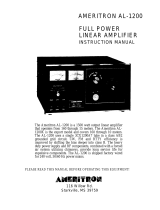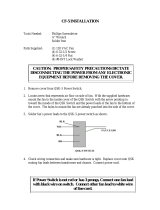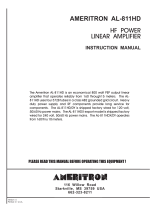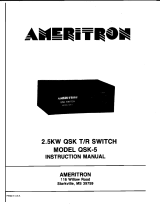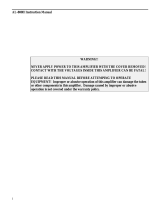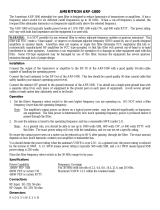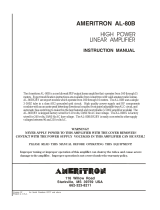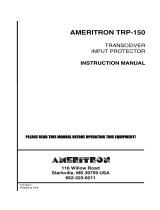Page is loading ...

Ameritron AL-572 Instruction Manual
i
Table of Contents
Introduction.................................................................................................................................1
Unpacking Instructions................................................................................................................2
Features .......................................................................................................................................3
AL-572 Technical Specifications................................................................................................4
Input ................................................................................................................................4
Output..............................................................................................................................4
Efficiency........................................................................................................................ 4
Power Supply ..................................................................................................................4
Tube.................................................................................................................................5
Metering..........................................................................................................................5
ALC.................................................................................................................................5
Relay................................................................................................................................5
Connectors.......................................................................................................................5
Physical ........................................................................................................................... 5
General Information .................................................................................................................... 6
Safety Interlock ...............................................................................................................6
Peak Envelope Power vs. Average Power.......................................................................6
Circuit Descriptions.....................................................................................................................7
ALC.................................................................................................................................7
Dynamic Bias..................................................................................................................7
Wattmeter Circuit............................................................................................................8
Power Supply ..............................................................................................................................8
Filament Supply .............................................................................................................. 8
Plate (HV) Supply...........................................................................................................8
Meters.......................................................................................................................................... 8
Current Meter (plate and grid).........................................................................................8
Multimeter.......................................................................................................................9
Multimeter Functions..........................................................................................9
HV...........................................................................................................9
REF..........................................................................................................9
ALC.........................................................................................................10
ALC SET.................................................................................................10
Tube Life.....................................................................................................................................10
Export Modifications ..................................................................................................................11
Technical Assistance...................................................................................................................12
Notes................................................................................................................................12
Installation Guidelines And Suggestions ....................................................................................13
Location Of The Amplifier..............................................................................................13
Ventilation.......................................................................................................................13
Power Connections..........................................................................................................13
Grounding........................................................................................................................14
Transformer Connections................................................................................................ 15
Interconnections ..........................................................................................................................16

Ameritron AL-572 Instruction Manual
ii
Operating Instructions And Guidelines....................................................................................... 16
Front Panel Controls........................................................................................................16
"MULTIMETER" Switch ...................................................................................16
"OFF-ON" Switch............................................................................................... 16
"STBY-OPR" Switch..........................................................................................16
"PLATE" Control................................................................................................17
"LOAD" Control .................................................................................................17
ALC Metering, Controls, and Adjustments.....................................................................17
ALC Metering Functions.....................................................................................17
ALC.........................................................................................................17
ALC SET.................................................................................................18
ALC Controls...................................................................................................... 18
ALC Adjustments................................................................................................ 18
SSB Operation.........................................................................................18
CW Operation .........................................................................................18
Rear-panel "ALC LIMIT" control.......................................................................19
ALC Limit Adjustment (rear panel).................................................................... 19
Driving Power.................................................................................................................20
Tube and Component Life...............................................................................................20
Tuning .............................................................................................................................21
Tuning Procedure................................................................................................22
"ALC SET" control ............................................................................................. 24
Additional SSB Notes ..................................................................................................... 25
AM (Amplitude Modulation) Operation.........................................................................25
Audio Distortion.............................................................................................................. 25
FM (Frequency Modulation), RTTY, and DIGITAL OPERATION ..............................26
QSK Operation................................................................................................................26
Periodic Maintenance.................................................................................................................. 26
Parts List......................................................................................................................................28
Power Supply / SWR Board (50-0057-1).......................................................................28
Tuned Input Board (50-0057-2) ...................................................................................... 29
AL-572 Tuned Input Chart.............................................................................................. 29
Meter Board (50-0057-3) ................................................................................................29
Timer / Overload Board (50-0057-5)..............................................................................30
AL-572 Main Chassis Parts List ..................................................................................... 31
AL-572 Wiring Diagram............................................................................................................. 32
Power Supply / SWR Board Schematic..........................................................................33
Tuned Input Board Schematic......................................................................................... 34
Meter Board Schematic................................................................................................... 35

Ameritron AL-572 Instruction Manual
1
Ameritron AL-572
1300 watt PEP Linear Amplifier Instruction Manual
I
NTRODUCTION
The Ameritron AL-572 is a 1000 watt CW, 1300 watt PEP (nominal output power) linear
amplifier that operates on all Amateur bands from 160 through 15 meters (WARC bands and ten
meters with reduced performance). The AL-572X and AL-572Y are export models that operate
from 160 through 10 meters.
The AL-572 uses four 572B tubes in a class
AB
2
grounded grid circuit. High-quality power
supply and RF components combine with an accurate peak-detecting directional coupler, front
panel adjustable true ALC circuit, and automatic bias switching to make this the best featured
and most reliable 572B amplifier available. The AL-572 and AL-572Y are factory-wired for 120
volt, 50/60 Hz ac line voltage. The AL-572X is factory wired for 240 volts. All models are easily
converted to other supply voltages between 90 and 250 volts ac.
DANGER: NEVER APPLY POWER TO THIS AMPLIFIER WITH THE COVER
REMOVED! CONTACT WITH THE VOLTAGES INSIDE THIS
AMPLIFIER CAN BE FATAL!
PLEASE READ THIS MANUAL BEFORE ATTEMPTING TO OPERATE EQUIPMENT!
WARNING: Improper or abusive operation of this amplifier can
damage the tubes or other components in this amplifier.
Damage caused by improper or abusive operation is not
covered under the warranty policy.
Ameritron
116 Willow Road
Starkville, MS 39759
(662) 323-8211

Ameritron AL-572 Instruction Manual
2
UNPACKING INSTRUCTIONS
Remove the AL-572B tubes from their shipping cartons. Carefully inspect each tube for visible
damage. Look for bent or broken pins. Roll each tube over slowly while listening and watching
for loose internal materials. Contact either your Ameritron dealer or Ameritron immediately if
any damage exists.
Carefully lift the amplifier from the shipping carton, and place it on a firm, level surface. Inspect
the amplifier for shipping damage. Contact either your Ameritron dealer or Ameritron
immediately if any damage exists. Remove the cover screws with a #2 Phillips screwdriver.
Save the screws to re-secure the cover. Carefully lift the rear of the cover while sliding the cover
back. The AL-572 is shipped with the fuses and fuse caps packed inside the amplifier.
Additional screws will be included in the fuse pack when required.
DANGER: Never remove the cover while this amplifier is connected
to the power mains! Contact with the voltages in this
amplifier can be fatal.
The tubes must be installed in their sockets prior to operation. Observe the pin configuration on
each tube and socket. Two of the of the four base pins are slightly larger in diameter. Carefully
observe the pin alignment to be sure correct tube pins are centered on the socket's holes. Firmly
press the tubes into the socket. Do NOT twist or force the tubes into their socket.
Install the anode connector on the tube's anode terminal.
Install the fuses and fuse caps on the back of the amplifier. This amplifier uses two 20A fuses for
standard 120 Vac operation (models B and BY) or two 12A fuses for 240 V operation (model BX
only). If you wish to operate the amplifier on a line voltage other than 120 volts, the jumpers on
the power transformer primary windings must be changed. If the primary wiring is changed, the
correct fuses must be installed. See the "T
RANSFORMER
C
ONNECTIONS
" section on page 15 for
more information.
CAUTION: Always use fast-blow fuses rated at 250 volts or
higher. NEVER use standard automotive glass fuses or
slow-blow fuses.
The top cover should now be installed with the ventilation holes on side of the cover positioned
near the electrolytics. The ventilation holes on the top of the cover should be on the right side of
the amplifier (front view). Secure the cover by installing the corner screws first. Install all the
screws loosely until every screw is in place.
Tighten the screws
after
they have all been
installed.
Note: Ameritron will NOT be responsible for shipping damage due to improper packing.
The packing materials used to ship this amplifier are specially designed to prevent damage. All
packing materials should be retained for future shipping. Replacement packing materials may be
purchased from Ameritron if original packing materials are unavailable.

Ameritron AL-572 Instruction Manual
3

Ameritron AL-572 Instruction Manual
4
FEATURES
+ The AL-572 uses rugged inexpensive 572B tubes.
+ The 572B requires only a few seconds of warm-up time.
+ A dynamic bias circuit eliminates hundreds of watts of unnecessary heat generation in the
power amplifier tubes. The result is cooler operation and longer component life.
+ A multi-voltage heavy-duty transformer with a unique "buck-boost" winding allows
adjustment of the primary voltage to 14 different voltages centered on 115 and 230 volts. This
versatile Ameritron feature allows the user to select the optimum primary voltage for
maximum performance and life.
+ The tuning and loading controls have vernier 6:1 reduction drives for smooth tuning.
Logging scales allow quick and repeatable control adjustments for rapid band changes.
+ The AL-572 has two illuminated cross-needle panel meters. The left meter provides a
continuous reading of grid and plate currents. The right meter reads peak RF power output on
one scale and Plate Voltage (HV), Reflected power and SWR (REF), ALC detector voltage
(ALC), and ALC adjustment level (ALC SET) on the other scale.
+ Filament and plate voltages are maintained using the "STBY/OPR" switch. This allows the
amplifier to be conveniently bypassed for "barefoot" operation.
+ A front panel "ALC SET" control allows convenient adjustment of the ALC threshold. The
unique ALC circuit samples the grid current and power supply voltage.
+ An "XMT" LED on the front panel indicates proper keying of the amplifier by the exciter.
+ A rear panel "12 V" auxiliary output jack provides up to 200 mA at 12 Vdc for accessories
such as the ATR-15 Antenna Tuner.
+ A step-start circuit limits the inrush current to the power supply and tube filament. This
circuit extends the life of the amplifier components.

Ameritron AL-572 Instruction Manual
5
AL-572 TECHNICAL SPECIFICATIONS
I
NPUT
Circuit type:...............................................................Pi-network, slug tuned coils
Maximum VSWR at resonance:................................ 1.3:1 or less
Minimum 2:1 VSWR bandwidth:............................. typically 15% of center frequency
Maximum SSB drive power permissible: .................110 watts PEP
Typical drive for full CW power output:................... 75 watts
O
UTPUT
Circuit type:...............................................................Pi-L, Pi-network
Typical SSB PEP voice operation:............................1300 watts nominal
CW continuous operation:.........................................1000 watts nominal
1/2 hour PEP two-tone test:.......................................1000 watts
1/2 hour continuous carrier (RTTY): ........................not rated, contact factory for specification
Frequency Coverage:.................................................1.8 to 21 MHz amateur bands. (Export
models include 24.5 and 28 MHz at reduced
power. WARC bands available at reduced
power)
Third Order IMD:...................................................... -34 dB or better (below PEP at rated output)
E
FFICIENCY
CW ............................................................................approximately 61%
SSB............................................................................ approximately 65%
(envelope crest)
P
OWER
S
UPPLY
Circuit type:...............................................................Full wave voltage doubler
No load voltage:........................................................2900 V
Full load voltage:.......................................................2500 V
Full load current:........................................................7 A
NL to FL Regulation: ................................................14% or less internal voltage drop
Transformer:.............................................................. 21 lbs
Capacitors:.................................................................26 mFd total, computer grade

Ameritron AL-572 Instruction Manual
6
Normal line current at rated CW output:...................16 A at 120 Vac
Normal line current at 1300 watt PEP output: ..........8 A average at 120 Vac
Power line current in standby:................................... 2 A at 120 Vac
T
UBE
Type:..........................................................................(4x) 572B
Continuous dissipation:.............................................640 watts
Warm-up time: ..........................................................3 seconds
M
ETERING
Multimeter:................................................................Peak forward power (continuously). The
second scale switches between peak
reflected power (and SWR), ALC threshold,
ALC output voltage, and high voltage.
Current meter: ........................................................... Plate and grid current (simultaneously) on
separate scales.
ALC
Negative going, 0 to 10 volts, adjustable.
R
ELAY
Requires contact closure or sink of +12 Vdc at 100 mA. Back pulse protected.
C
ONNECTORS
RF:.............................................................................SO-239
Line: .......................................................................... NEMA 5-15P, standard 120 V three wire
Others:.......................................................................RCA Phono
P
HYSICAL
Dimensions:...............................................................15-1/2" D x 14-1/2" W x 8-1/2" H
Weight:......................................................................40 lbs.

Ameritron AL-572 Instruction Manual
7
GENERAL INFORMATION
S
AFETY
I
NTERLOCK
An interlock switch is closed while the amplifier's top cover is in place. This switch completes
the primary circuit of the power transformer. The interlock will open and de-energize the
transformer primary if the top cover is removed.
DANGER: High voltage can kill! Accidental contact with the
voltages in this amplifier can be lethal.
For your personal safety please observe the following precautions:
1. NEVER defeat the interlock.
2. NEVER remove the cover with the amplifier connected to the power line.
3. ALWAYS allow the capacitors to discharge for several minutes after
unplugging the
amplifier and before removing the cover.
4. ALWAYS select the high-voltage (HV) function of the Multimeter to check the high voltage
potential. Do
not remove the cover if voltage is indicated.
5. ALWAYS ground the tube anode (top metal connector) to the chassis through a low value,
high wattage resistor before touching anything inside the amplifier.
6. ALWAYS be cautious of heat. Many components inside the amplifier operate at high enough
temperatures to cause burns.
7. NEVER make any unauthorized component or circuit modifications to this product. The
only acceptable source for modifications is Ameritron or a source approved by Ameritron.
Unauthorized modifications almost certainly will increase the risk of equipment failure or
personal injury.
P
EAK
E
NVELOPE
P
OWER VS
. A
VERAGE
P
OWER
Peak envelope power (PEP) is often misunderstood by amateurs. PEP
is not
associated with the
sine wave or root-mean-square (RMS) power, and PEP has no fixed ratio to average power on
any mode except FM, FSK or CW. It is impossible to use a formula or "rule of thumb"
approximation to convert between average and peak voice waveform powers.
PEP is the power at the crest (highest point) of the RF envelope waveform. On SSB, the average
power can vary from a few percent to more than half the PEP produced. Generally, PEP on SSB
is two to five times greater than the average power. A 50 watt average power SSB signal could
produce PEP levels from below 100 watts to more than 250 watts.
On CW and other constant amplitude modes (such as FM or RTTY), the PEP is
always
equal
to
the average power. For example, on CW, FM, or RTTY 1000 watts of average power produces
exactly 1000 watts of PEP.

Ameritron AL-572 Instruction Manual
8
CIRCUIT DESCRIPTIONS
ALC
The AL-572 is one of the few amplifiers using a "true" automatic level control (ALC) circuit. In
this amplifier, the ALC actually samples grid current and power supply loading to determine the
ALC voltage. The front panel "ALC SET" knob adjusts the level of grid current where ALC
action begins. ALC action begins softly over a range of a few milliamperes to minimize
distortion. This soft-touch ALC is an Ameritron exclusive.
The ALC circuit is located on the METER BOARD P/N 50-0080-3 (behind the
"MULTIMETER" switch). IC301 (pins 9 and 10) compares the voltage drop (caused by grid
current) across R106 in the main power supply board. ALC voltage is derived by comparing the
grid shunt voltage to the voltage from the power supply.
The pin 8 output of IC1 will go negative if the grid shunt voltage exceeds the voltage from
divider R311 and R2 (chassis mounted control), or if the supply voltage sags from excessive line
voltage drop. Pin 8 is followed by current buffer Q303 that sources the negative ALC voltage to
the ALC output jack.
This amplifier includes an ALC Limit control on the rear panel. This control reduces overshoot
and eliminates motorboating (a slow rhythmic fluctuation) in the transmitted signal. These
problems are caused by excessive transceiver ALC attack time delay. This control sets the
maximum voltage level available from the ALC circuit. Adjustment details begin on page 17.
D
YNAMIC
B
IAS
Conventional bias circuits force high power linear amplifiers to dissipate hundreds of watts
during low or no signal periods. This creates needless heat, since virtually no dissipation is
required unless the amplifier is being driven with large signal levels.
The AL-572 contains an exclusive bias circuit that reduces the idling (quiescent) current very
close to the tube's cut-off region. The power amplifier tube in the AL-572 has a full resting
period of very low dissipation between dots and dashes on CW and between words on SSB. The
lower idling current reduces component temperature on both CW and SSB. If only a few
milliwatts of RF power are applied to the amplifier, the quiescent current will increase. Linearity
remains excellent with this circuit because the tube can remain biased for class AB operation
without unnecessary standing dissipation.
The dynamic bias circuit is located on the Power Supply Board P/N 50-0080-1. Diodes D101
and D102 rectify a small sample of the RF drive voltage. This voltage is applied to the base of
dc switch Q101. If Q101's base is driven with a few microamperes of current from the RF
sampling circuit, Q101's collector will pull the base of PNP transistor Q102 low. This turns dc
switch Q102 on.
When Q102 is on, zener diode D103 is connected between the collector and base of Q103.
D103 sets the operating bias. This zener applies forward bias to Q103's base whenever the
collector voltage of Q103 exceeds the voltage of D103. This forward bias will turn Q103 on
harder and will reduce the collector voltage. If the collector voltage is less than the breakdown

Ameritron AL-572 Instruction Manual
9
voltage of D103, Q103 will move towards cut-off and the collector voltage will increase. Q103
functions as a current buffer for zener diode D103.
W
ATTMETER
C
IRCUIT
The AL-572 wattmeter circuit uses an accurate directional coupler followed by a true peak
detector circuit. This circuit will accurately determine the true peak envelope power (PEP) of
normal voice waveforms. If the load SWR is high, the true power reading will be obtained by
subtracting the reflected power from the forward power.
POWER SUPPLY
F
ILAMENT
S
UPPLY
The filament circuit of this amplifier satisfies
all
requirements of the tube manufacturer related to
tube performance and life. The filament voltage and inrush current are controlled by the power
transformer's internal resistance and impedance, filament choke resistance, filament wiring
resistance, and the step-start circuit. NEVER replace any circuit components or wiring with
substitute parts. This precaution will insure maximum life for the tube.
P
LATE
(HV) S
UPPLY
The plate supply uses a full wave doubler circuit with 200 amp surge rated diodes and a heavy
duty 21 pound transformer. Filtering is accomplished by a bank of high quality computer grade
capacitors totaling 26 mFd. Large 50k ohm, 7 watt bleeders are used for safety and superior
voltage equalization. The transformer allows user selection of fourteen different line voltages
(see the "T
RANSFORMER
C
ONNECTIONS
" section on page 15 for details).
Power is supplied through "OFF-ON" switch S2. A 10 ohm resistor (R27) limits the line current
during the filter capacitor charge time to lower component stress. When the filter capacitor
charging current decreases sufficiently, RLY102 shorts the 10 ohm resistor. This applies full
power line voltage to the transformer. The 10 ohm resistor is protected from high-voltage supply
shorts by a 2A slow-blow fuse (F101) during start-up. If F101 or the 10 ohm resistor (R27) fails
the amplifier will not start. If F101 fails from a momentary HV to ground fault, meter protection
diode D117 may also fail. See the "Metering Functions" section that follows for more
information.
METERS
C
URRENT
M
ETER
(
PLATE AND GRID
)
The plate and grid current meter is located on the far left side of the front panel. This meter
indicates the plate current (Ip) on the right-hand meter scale. This scale has a small picket every
25 mA, a large picket every 100 mA, and indicates 1000 mA at full deflection.

Ameritron AL-572 Instruction Manual
10
The left-hand meter scale indicates the grid current (Ig). The small pickets on this "Ig" scale
appear every 10 mA and the larger pickets appear every 50 mA. The full scale "Ig" reading is
250 mA.
The plate and grid meters in this amplifier normally indicate maximum grid current and
maximum RF output at or near the same "PLATE" tuning setting. Maximum grid current and
minimum plate current also generally occur at the same "PLATE" tuning setting.
Note: If the grid and plate meters always track (move together in exact step) as the tuning
controls are adjusted and if they show the same approximate amount of pointer
movement, diode D117 on the power supply board could be shorted.
D117 protects the grid current overload circuit (if used) and the meters. This diode is located near
the electrolytic capacitors on outside edge of the main circuit board. D117 will usually short if
there is a large high-voltage-to-chassis current fault. The grid and plate current meters will not
read correctly if this diode fails. If D117 is shorted the overload circuit (if used) may repeatedly
trip and grid current may appear excessively high before full power is reached.
M
ULTIMETER
The multimeter is the meter on the right. It continuously reads the forward peak envelope power
on its left-hand scale (FWD). This scale is calibrated in 100 watt steps up to 2 kW.
The right-hand scale of this meter provides four metering functions that are selected by the
"MULTIMETER" switch. These functions include the measurement of high voltage (HV),
reflected power and SWR (REF), ALC voltage output (ALC), and relative ALC threshold (ALC
SET). The "Multimeter Functions" section that follows describes these functions in more detail.
Multimeter Functions
HV
The multimeter indicates the dc plate voltage applied to the PA tube when the MULTIMETER
switch is placed in the HV position. The correct scale to use is the ALC/ HV scale. This scale has
a picket every 100 volts. Two zeros must be mentally added behind the numbers indicated on the
meter scale (i.e. multiply by 100), so that "25"=2500 volts and "20"=2000 volts. Do not operate
the amplifier if the high voltage is over 3000 volts with the amplifier on standby. See the
"T
RANSFORMER
C
ONNECTIONS
" section on page 15 for information on correcting excessive high
voltage.
REF
The multimeter measures the antenna (or load) peak envelope reflected power and the SWR
when the MULTIMETER switch is placed in the REF position. The full scale reflected power
reading is 500 watts. This scale is marked every 10 watts below 100 watts, and every 100 watts
from 100 to 500 watts.
Note: The SWR of the load is measured when the "MULTIMETER" is in the REF
position by observing the different red SWR curves. The forward and reflected
power meter pointers will cross each other on, or near, the correct SWR curve.

Ameritron AL-572 Instruction Manual
11
ALC
The multimeter measures the output voltage of the ALC detector when in the ALC position. The
full scale ALC reading is 35 volts and is read directly from the ALC/ HV scale. The meter
should flick upwards occasionally during normal ALC action.
ALC SET
The multimeter measures the
approximate
grid current that will produce ALC activity when the
meter switch is in the ALC SET position. One zero must be added to the reading on the ALC/
HV scale for this function. For example, ALC action will begin at approximately 150 mA of grid
current (typically between 120 mA and 180 mA) when the "ALC SET" control is adjusted until
the meter reads "15."
TUBE LIFE
The 572B is a reasonably rugged tube. The likelihood of premature failure can be reduced by
avoiding excessive tube element temperatures. Element temperature is a function of the duration
and the amount of power dissipated. The elements in the 572B have very good immunity to short
term overload failures.
The anode in the 572B can tolerate large dissipation overloads for short periods of time due to
the thermal mass of the anode. Anode color is a good indication of incorrect tube operation. The
anode in the 572B is designed to operate at moderate temperatures. These temperatures normally
do NOT produce anode color.
The graphite anode is coated or mixed with a "getter" material that de-gasses the tube. This
material is activated by normal operating anode temperatures. The likelihood of gas failure (tube
arcing) is reduced by operating the 572B tubes on a regular basis at normal ratings.
Care must be taken to avoid exceeding the temperature ratings of the tube's glass-to-metal seals.
The life of the tubes in this amplifier may be prolonged if tuning periods are kept short and a
brief "cool-down" periods are provided between tuning periods. Try to allow a one or two minute
non-transmitting "cool-down" period after lengthy CW or RTTY transmissions before shutting
off the AC power switch.
Incorrect operation is most likely to damage the tube's control grid or anode. Applying full drive
power for several seconds with excessively "light" loading (indicated by abnormally high grid
current) can cause control grid damage. Several seconds of high drive power operation with
improper tuning or excessively "heavy" loading (indicated by low output power in concert with
normal plate current) can melt or damage the anode. These undesirable operating conditions can
be avoided by following the tuning procedures in this manual.
In the AL-572, a grid current of 200 mA (at 100 watts of drive) produces rated grid dissipation.
For maximum tube life, the short-term average grid current and drive power should always be
kept below these values.

Ameritron AL-572 Instruction Manual
12
WARNING: NEVER drive this amplifier with more than 100 watts of
short term average envelope power. NEVER allow the
grid current to exceed 200 mA under any operating
condition.
Maximum power output normally will occur with approximately 125 mA of grid current on CW,
or less than 45 mA of grid current (125 mA instantaneous peak) on SSB (two-tone test). Grid
dissipation, with 125 mA of grid current and 70 watts of drive, is approximately ten watts.
If you wish to add control grid protection to the AL-572, always remember fuses and resistors are
too slow and unpredictable to adequately protect tubes. While grid protection is generally not
required with tubes like the 572B, Ameritron does offer an optional fast-acting electronic circuit
that will rapidly disable the amplifier if excessive grid current occurs. This circuit also reduces or
eliminates the chance of tank component damage from incorrect loading or load failure. The part
number of this add on board is 50-0080-5.
The continuous commercial plate current rating of each 572B is 275 mA. For maximum tube life,
total plate current should be maintained below 1100 mA on CW and other "steady" carrier
modes. Brief periods of plate current exceeding 1100 mA will not cause loss of emission or
shorten the amateur service life of the tubes in this amplifier.
The application of filament voltage causes thermal stresses from rapid and uneven temperature
changes. Avoiding needless cycling of the filament can prevent premature failure or unnecessary
stress in the tube's filament.
An accumulation of gas (or stray debris) in the tube can cause the tube to arc between the anode
and the other elements of the tube. The resulting "gas arc" will generally manifest itself as a loud
"pop" when the amplifier is first turned on. A "gas arc" will often damage diode D117 on the
negative rail of the filter capacitor bank and open the fuses in the amplifier. If this problem
occurs frequently, the tube should be tested or replaced. The use of low quality tubes, tubes that
have been stored for extended periods, or abused tubes increase likelihood of a "gas arc".
Ameritron recommends using only current code date 572B tubes.
EXPORT MODIFICATIONS
A simple modification will allow operation on frequencies above 15 meters. Instructions for this
modification are available by sending a written request for "Export Modification Instructions"
along with a copy of a valid amateur license. There is no charge for this information. Export
models are shipped with this modification installed and have an "X" or "Y" following the serial
number.
Address: Ameritron
116 Willow Road
Starkville, MS 39759
FAX: (662) 323-6551

Ameritron AL-572 Instruction Manual
13
TECHNICAL ASSISTANCE
Technical assistance is available during normal central standard time business hours on
weekdays. Customer service is more effective when our technicians are provided the following
information:
1. Model and serial number
2. Date of purchase and dealer
3. An accurate description of the problem
Meter readings at all stages of the tuning procedure are very important along with a complete
description of the other equipment used with our product.
Written assistance is also available. Due to time delays in processing mail, please allow at least
three weeks for a written reply. For service or written correspondence, use the following address:
AMERITRON
116 Willow Rd.
Starkville, MS. 39759
Telephone: (662) 323-8211
FAX: (662) 323-6551
Note:
Service history has clearly shown that most problems are operating or installation
errors, rather than equipment failures. Most problems can be resolved over the
telephone. Please contact our staff before shipping parts or equipment to us.
The packing materials used to ship this amplifier were specially designed to prevent shipping
damage. The original packing materials should be used to ship this amplifier. Replacement
packing materials may be purchased from Ameritron if original packing materials are unavailable
or damaged.
CAUTION: Never ship this amplifier with the tube installed.
Ameritron will not be responsible for shipping damage
caused by improper packing.
N
OTES

Ameritron AL-572 Instruction Manual
14
INSTALLATION GUIDELINES AND SUGGESTIONS
L
OCATION
O
F
T
HE
A
MPLIFIER
Do not install the amplifier in excessively warm locations or near heating vents or radiators. Be
sure air can circulate freely around and through the amplifier cabinet. Provide an unobstructed
cold air inlet for the amplifier. DO NOT place any books, magazines or equipment that will
impede the free flow of air near or on the cabinet ventilation holes.
V
ENTILATION
The AL-572 ventilation system has been designed and tested to maintain tube seal temperatures
safely below the tube manufacturer's rating at 600 watts of continuous carrier or 1300 watts of
two tone power output when the amplifier is properly tuned. The fan in the AL-572 is a
permanently lubricated type that requires no maintenance in normal operation. To insure
adequate cooling in your installation, please observe the following:
1. Do not block or unduly restrict the ventilation holes in the cover. Be sure that the amplifier is
located in an area so the ventilation holes have open air circulation. It is particularly important
to avoid restricting the air inlet.
2. The exhaust airflow is over 30 CFM. Do not "assist" the exhaust airflow with cabinet
mounted fans.
3. The most efficient way to improve airflow is to pressurize the air
inlet
area. Be sure that any
fan used to assist the inlet airflow has
at least
a 60 CFM rating.
4. The exhaust air will become quite warm at high power levels. Do not place any heat sensitive
objects in the exhaust air stream.
P
OWER
C
ONNECTIONS
The AL-572 is supplied with a NEMA 5-15P plug for 120 Vac operation. Full duty cycle
operation with ac supply voltages below 100 volts is not recommended. The "T
RANSFORMER
C
ONNECTIONS
" section on page 15 show the correct wiring for various supply voltages.
This amplifier has a current demand of 16 amperes at 120 Vac with 1000 watts of RF carrier
output. The average power line current during voice peaks on SSB will be approximately 9
amperes at 1300 watts PEP output. Most normal residential power lines and house-wiring will
easily meet this current requirement.
If the power mains have excessive resistance, the high voltage may sag to less than 2500 volts
under load. Voltage sag will not hurt the amplifier if the fully loaded high voltage remains above
2350 volts.
CAUTION: Never allow the high voltage to exceed 3000 volts under
any condition.

Ameritron AL-572 Instruction Manual
15
For 120 volt operation, the wiring between the fuse box and the amplifier ac outlet must be
number 14 gauge (or larger) in order to supply the current required (16 A) without a significant
drop in the line voltage. The 120 volt outlet should be fused for 20 amperes.
G
ROUNDING
Connect a good RF and dc ground to the ground post on the rear panel of the amplifier. Use the
heaviest and shortest connection possible. The best materials to use for ground connections are
(in order of effectiveness) smooth wide copper flashing, copper tubing, or solid copper wire.
Never use braided or woven conductors unless the lead needs to be flexed. Braided or woven
conductors offer a much higher impedance to lightning and RF than an equivalent solid
conductors.
Water pipes, metal heating ducts, metal fences and other large metallic masses offer convenient
RF grounds. If a water pipe ground is used, inspect all the pipe connections to be sure that no
plastic or rubber connections are insulating the pipes. Insulated pipe connections will interrupt
the electrical continuity in the water supply system. Install a jumper around any insulated pipe
connections you find. Use heavy copper wire or flashing with stainless hose or pipe clamps for
the jumpers.
The following tips will help prevent lightning damage and RF grounding problems:
1. Avoid using braided or woven conductors, they have very high resistance for RF and
lightning. Remember that RF and lightning flows along the surface of conductors, almost no
current flows in the center of the conductor. The lowest RF resistance occurs with large
surface area, smooth conductors.
2. Avoid routing a single small gauge conductor along the various pieces of equipment (or to
connect multiple ground sources). Instead, use multiple ground leads that connect to a single
wide buss at the operating position. Keep all ground leads as short and wide as possible.
3. Buried radials provide much better lightning and RF ground connections than ground rods do,
although both are needed for safety.
4. Avoid sharp bends in ground leads. When changing the direction of a ground lead use a
gradual radius turn.
5. Avoid second story operation. A good ground is much easier to obtain on the first floor or in
the basement of a structure.
6. Air-core choke baluns should be used on all coaxial feedlines. The feedlines should be coiled
into several 4" to 6" diameter turns
before
they
enter the building. Either directly bury the
feedlines a few inches deep in the ground for a minimum distance of ten feet or ground the
shields to a separate earth ground on the antenna side of the choke.

Ameritron AL-572 Instruction Manual
16
T
RANSFORMER
C
ONNECTIONS
The power transformer can be adjusted for various power line voltages by changing a group of
jumper wires located near the outside edge side of the large power supply circuit board. These
jumpers are located above the power transformer and have letters and numbers plainly marked on
the circuit board. The jumper connection points are labeled A through F and 1 through 3.
120 volt operation will normally be adequate in most situations. Operating this amplifier on 240
volts may be advantageous if the 120 volt power mains have abnormally high resistive loss. 240
volt operation is advisable when house lights dim or "blink" during operation or if the amplifier's
HV drops below 2500 volts at full output. For maximum safety, never operate this amplifier on
mains that use fuses or circuit breakers rated above 25 amperes on 120 volts, or 15 amperes
on 240 volts.
The power transformer of the AL-572 has fourteen different voltages available on the primary
and is rated at full power on frequencies of 50 and 60 Hz. The jumper connections chart below
indicates the proper placement of jumpers for various power line voltages.
The high voltage secondary of the AL-572 has three leads. The normal wiring is indicated on the
circuit board silk-screen by the initials R/Y (RED/YELLOW) and R/G (RED/GREEN). For low
power operation the R/Y and R/G wire can be reversed. This will reduce the plate voltage of the
AL-572 to permit operation at output levels below 400 watts.
WARNING: The AL-572 requires different back panel fuses for
various line voltages. Use the fuse listed in the
jumper connections chart for maximum protection.
JUMPER FROM TOP LETTERS
TO BOTTOM LETTERS IN COLUMN
HIGHEST
LINE-V
A
B
C
D
E
F
LINE
FUSE
205 C B 3 1 12
215 C B 3 2 12
220 C B 2 1 12
230 C B F E 10
240‡ C B 1 2 10
245 C B 2 3 10
250 C B 1 3 8
90 B A D C 3 1 25
100 B A D C 3 2 25
110 B A D C 2 1 25
115 B A D C F E 20
125† B A D C 1 2 20
130 B A D C 2 3 20
140 B A D C 1 3 15
†Factory wired Model AL-572 and AL-572Y
‡Factory wired Model AL-572X

Ameritron AL-572 Instruction Manual
17
I
NTERCONNECTIONS
1. Connect the exciter's RF output to the "RF IN" connector on the rear of the AL-572 with 50
ohm coax. Use any good quality 50 ohm cable long enough to connect the amplifier to the
exciter. This amplifier connection uses a standard SO-239 female that mates with a PL-259
male connector on the cable.
2. Connect the existing station antenna system to the "RF OUT" connector on the rear of the AL-
572 with RG-8 type coax. This amplifier connection uses a SO-239 female that mates with a
PL-259 connector on the cable.
3. Shielded audio type cable with a standard male phono plug should be used to connect to the
"RLY" jack on the AL-572. This jack has positive 12 Vdc open circuit and supplies 100 mA
of current when pulled to ground. The relay circuit has an internal back pulse canceling diode
to protect sensitive exciter circuits from damage.
4. Connect a short, wide, and smooth ground lead from a good earth and RF ground to the rear
panel "GND" terminal. Avoid using braided conductors for ground leads.
5. The "12 V" connection on the rear panel provides 12 Vdc at 200 mA maximum to operate
external dial lamps or accessories such as the ATR-15 Antenna Tuner.
6. Connect the "ALC" jack to the ALC input of the exciter with a shielded cable and a phono
plug. The proper connection point on the exciter should be indicated in the exciter's manual.
The AL-572 ALC will operate with any exciter that uses a negative-going ALC voltage of up
to 10 volts.
Note: Transceiver ALC response times and ALC voltage requirements vary with different
manufacturers.
OPERATING INSTRUCTIONS AND GUIDELINES
F
RONT
P
ANEL
C
ONTROLS
"MULTIMETER" Switch
This four position switch selects either the plate voltage (HV) of 0-3500 volts, the reflected peak
envelope power (REF) of 0-500 watts, the ALC detector output voltage (ALC) of 0-35 volts, or
the approximate ALC grid current threshold (ALC SET) of 0-350 mA. See the "Metering
Functions" section on page 9 for more details.
"OFF-ON" Switch
This switch turns the main power off and on. When this switch is placed in the "ON" position
the fan should start, the meters should be illuminated, and high voltage should appear.
"STBY-OPR" Switch
This switch disables the amplifier's internal antenna relay. In the "STBY" position the amplifier
is bypassed without turning the tube's filaments or the power supply off.

Ameritron AL-572 Instruction Manual
18
This switch will also reset the grid protection circuit if an optional grid overload protection
circuit is installed. The overload circuit will be reset whenever this switch is placed in the
"STBY" position and returned to the "OPR" position.
"PLATE" Control
The "PLATE" control adjusts the output tank circuit to resonance. This control should
always
be
adjusted for maximum RF output power. Maximum RF output power normally occurs
simultaneously with maximum grid current and very close to the plate current "dip."
"LOAD" Control
This control adjusts the coupling of the amplifier to the antenna or load. This adjustment insures
optimum coupling between the tube and the load as the SWR of the load, the operating
frequency, or the power level is changed. Advancing the "LOAD" control clockwise increases
the RF power output capability and the linearity of the amplifier. Advancing the "LOAD"
control (clockwise rotation) also
decreases
the grid current and
increases
the plate current for a
given amount of drive.
The efficiency of the amplifier and the grid current decrease if the "LOAD" control is rotated
beyond the point of maximum output. The linearity, however, will increase. The proper position
for this control is
slightly
clockwise from the setting that produces maximum output with full
drive power applied to the input. Never use the "LOAD" control to adjust the output power.
Aways set power by reducing exciter power.
The "PLATE" control should always be checked after the "LOAD" control is adjusted by more
than one number. This is especially important at the high end of the "LOAD" range on 20 meters
and above. For example, if the "LOAD" is advanced from 7-1/2 to 8-3/4, the "PLATE" should be
re-tuned. If the "LOAD" is touched up only a slight amount, the "PLATE" setting will not
usually require re-adjustment.
ALC M
ETERING
, C
ONTROLS
,
AND
A
DJUSTMENTS
ALC Metering Functions
The "MULTIMETER" switch in the AL-572 has two positions that indicate the functioning of
the ALC circuit. These positions are as follows:
ALC
In this position the multimeter measures the output voltage of the ALC detector. The full scale
reading of the ALC detector voltage is 35 volts. It is read directly from the ALC/ HV scale of the
multimeter. The multimeter will indicate the maximum value of ALC voltage available from the
internal ALC circuit. The meter should flick upwards occasionally during normal ALC action in
this position.
/
